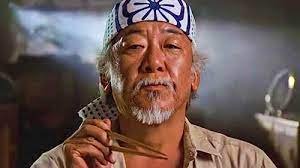Our Philosophy for Producing a Brand Video
A story is much easier to remember than a list of facts or promises, and the power of video images makes it even more remembered. Even if you have a lot of competition, your customers will still remember your company if you tell a visual story about it.
Contrary to popular belief, a brand video is not about you or your company. The brand video is about your client. In your brand story, your client is the hero. Your role in the story is the mentor or guide.
Think of yourself as Mr. Miyagi, Yoda, or Gandalf. Your job is to help the hero overcome the hero’s problem and transform the hero’s life.
In the Karate Kid, Mr. Miyagi guides Daniel on his journey to learn how to defend himself.
In Star Wars, Yoda teaches Luke Skywalker to control his feelings and resist the dark side.
Gandalf, in Lord of the Rings, mentors Frodo to success in helping him develop confidence, self-sufficiency and determination.
Identity Transformation
The Character Transformation is the first part of the video. "We know that you want to be different". As people, we all want to be changed and taken somewhere. This simple idea, which suggests that we want to be unique and different, sets up the character change that could happen if your client does business with you.
This sentence also shows a good amount of empathy. The words "we know" are a great way for a brand to make an emotional link with its audience... Remember that all choices are made based on how we feel. If your brand can make people feel that way, you win.
Philosophical Problem
In your Brand Narrative, the philosophical problem should answer the question, "Why is it just plain wrong to be burdened by this internal/external problem?"
This brand needs to fit the psychological problem. Here’s an example: “As a home buyer, you want to buy a house. Most of the time, these houses aren't perfect, and they don't feel like you. You deserve the perfect house." A simple comment like this can really make your audience nod and feel like "yeah, I do deserve this" as they listen to your story.
What your hero WANTS
To start the story, we need to know what the hero wants. In the home buyer example, they want to; "Buy the right house, then design and fix it up to make it your own."
External Problem
Once your brand has figured out what your hero wants, we need to present the problem.
The problem from the outside can be described or asked as;
"What is the thing that's stopping your hero from getting what they want?"
If talking about the features and benefits of your business is all you do, you are losing. The brands that win are the ones that talk about their customers' issues. By making the problem worse, you pull the customer deeper into the story.
Empathy and Problems Inside (We understand)
We tend to trust people who know us well. Many brands, unfortunately, forget to use sensitivity in their marketing. It's hurting their sales, too. If your company story doesn't include empathy, your product or service will become a commodity and lose value.
Use words like stress, anger, and confusion. This emotional language pulls the customer deeper into the story because it appeals to the main feelings that the customer has when making a purchase.
How to Fix It (the Solution)
At some point in your story, you need to talk about "WHAT" you have to offer. The important thing is to be as clear and brief as possible. Don't try to make it sound better or use fancy words. Clarity is always better than being smart! Here are two examples. Which one is easier to understand?
1) Joe’s Tech Shop is a full-service tech company that can fix both software and hardware.
2) Joe’s Tech Shop: We fix computers... quickly!
Do you know how #1 comes about? The boss of the business wants a headline that makes them stand out from their rivals... You'll lose if you confuse. If your website's "Bounce Rate" in Google Analytics is high, it's likely that you're confusing your visitors. Bounce Rate: The number of people who visit a website and then leave after only looking at one page.
Authority
Your customer (hero) is looking for signs that your brand can be trusted, signs that show your brand can do what it says it can do.
The trouble is that most brands want to tell the world how good they are and how many awards they have won. If you do this, you risk playing the hero. Remember that the star of the story is your customer, not your brand.
Instead, use small details to show that your brand is reliable; The Logos, Testimonials, Statistics, Thought Leadership. It’s all you need to show that you are in charge without being the Brand Hero.
A good example of a brand video
Process Plan
At this point in the story, it's likely that your client (hero) wants what you have to offer... but strange things start to happen in a consumer's thoughts. They start to doubt themselves. If they are about to click "buy now" or "schedule a call," they feel like they have something to lose. The magnitude of the deal is right in front of them...
Think about the last time you went online shopping and found a nice pair of shoes. You put them in your shopping cart, but you didn't finish your purchase.
A process plan (and an agreement plan) can help make the deal or process "look" easier and less risky for your customer. Try to lower the risk by breaking your process down into three easy steps.
Success
People will be drawn to a successful outcome. If your brand can show what success looks like, it will be easier for people to respond to your call to action. Remember, dozens of success-based pictures draw the customer closer to the Direct Call to Action.
Call to Action and Philosophical Language
So many brands waste money on videos that don't "ask for the sale." Almost every marketing piece you make should have a strong, clear Call-to-Action.
"Set up your meeting right away."
If you want to sell more, you need to ask for the sale. What do you want the person to do when they finish watching the video? (If you don't tell them, they won't take it). It’s good to add some philosophical words at the end such as "Because life is way too short to wait.” This is used to make the CTA stronger and give a sense of urgency without being too pushy.
Complete the Brand Video Worksheet Below
For us to develop a script for your brand video, we need you to share your thoughts. So, please answer the following questions:


